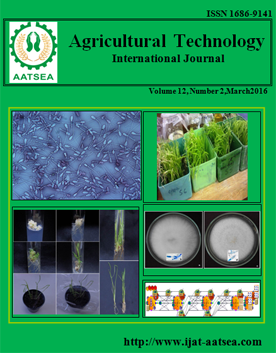Control mechanism of Chaetomium spp and its biological control of Citrus root rot in pot and field experiments in Vietnam
Main Article Content
Abstract
Chaetoglobosin-C produced from Chaetoimium globosum gave significantly inhibited colony, sporangia, and oospores growth of Phythothora parasitica causing root rot of citrus which the ED50 values of 4.0, 35.4 and 125.7 ppm respectively. The research finding in pot experiment showed that Chaetomium treatment at soil pH 3,4,5,6 and 7 gave highly significant better reduction the disease incidence than the metalaxyl chemical fungicide and non-treated control. Result in the field trial revealed that the disease index of cturs root rot caused by P. parasitica in Chaetomium biofungicide treatment was not significantly differed from Metalaxyl chemical fungicide when compated to the non-treated control. Chaetomium biofungicide reduced disease of 64 % and Metalaxyly chemical fungicide reduced the disease of 61.3 %. However, Chaetomium biofungicide treatment was also not significantly differed from Metalaxyl chemical fungicide in term of yield.
Article Details

This work is licensed under a Creative Commons Attribution-NonCommercial-NoDerivatives 4.0 International License.
References
Kanokmedhakul, S., kanokmedhakul, K., Nasomjai, P., Louangsysouphanh, S., Soytong, K., Isobe, M., Kongsaeree, P., Prabpai, S. and Suksamran, A. (2006). Antifungal azaphilones from Chaetomium cupreum CC3003. Joural of Natural Products 69:891-895.
Kanokmedhakul, S., Kanokmedhakul, K., Phonkerd, N., Soytong, K., Kongsaree, P. and Suksamrarn, A. (2002). Antimycobacterial anthraquinonechromanone compound and diketopiperazine alkaloid from the fungus Chaetomium globosum KMITL-N0802. Planta Medica 68:834-836.
Kean, S., Soytong, K. and To-anun, C. (2010). Application of biological fungicides to control citrus root rot in Cambodia. Journal of Agricultural Technology 6:219-230.
Levy, Y., Levi, R. and Cohen, Y. (1983) Buildup of a pathogen subpopulation resistant to a systemic fungicide under various control strategies: a flexible simulation model. Phytopathology 73:1475-1480.
Quyet, N. T., Cuong, H. V., Hong, L. T. H. and Soytong, K. (2014). Antagonism of Chaetomium spp and their ability to control citrus root rot caused by Phytophthora parasitica in Vietnam. Journal of Agricultural Technology 10:1307-1316.
Pechprome, S. and Soytong, K. (1997). Integrated biological control of Durian stem and root rot caused by Phytophthorapalmivora. Proceedings of the First International Symposium on Biopesticides. pp. 228-233.
Soytong, K., Kanokmedhakul, S., Kukongviriyapan, V. and Isobe, M. (2001). Application of Chaetomium species as new broad spectrum biological fungicide for plant diseases control. Fungal Diversity 7:1-15.
Soytong, K., Usawan, P., Kamokmedhakul, K., Kukongviriyapan, V. and Isobe, M. (1999). Integrated biological control of Phytophthorarot of sweet orange using mycofungicides in Thailand. Proceedings of the 5th International conference on Plant Protection in the Tropics. March 15-18. Malaysia. pp. 329-331.
Soytong, K. (1992). Antagonism of Chaetomiumcupreumto Pyriculariaoryzae. Journal of Plant protection in the tropics 9:17-24.
Soytong, K. and Quimio, T. H. (1989). Antagonism of Chaetomiumglobosumto the rice blast pathogen, Pyriculariaoryzae. Kasetsart Journal 23:198-203.
Timmer, L. W., Sandler, H. A., Graham, J. H. and Zitko, S. E. (1989). Phytophthorafeeder root rot of bearing citrus: Fungicide effects on soil populations of Phytophthora parasitica and citrus tree productivity. Proceedings of the Florida State Horticultural Society 102:5-9.
Tveit, M. and Moore, M. B. (1954). Isolates of chaetomiumthat protect oats from Helminthosporium victoriae. Phytopathology 44:686-689.
Usuwan, P. and Soytong, K. (1998). Biological control of Phytophthorarot of citrus in the field. Proc. of 24th Congress on Science and Technology of Thailand. pp. 862-863.


